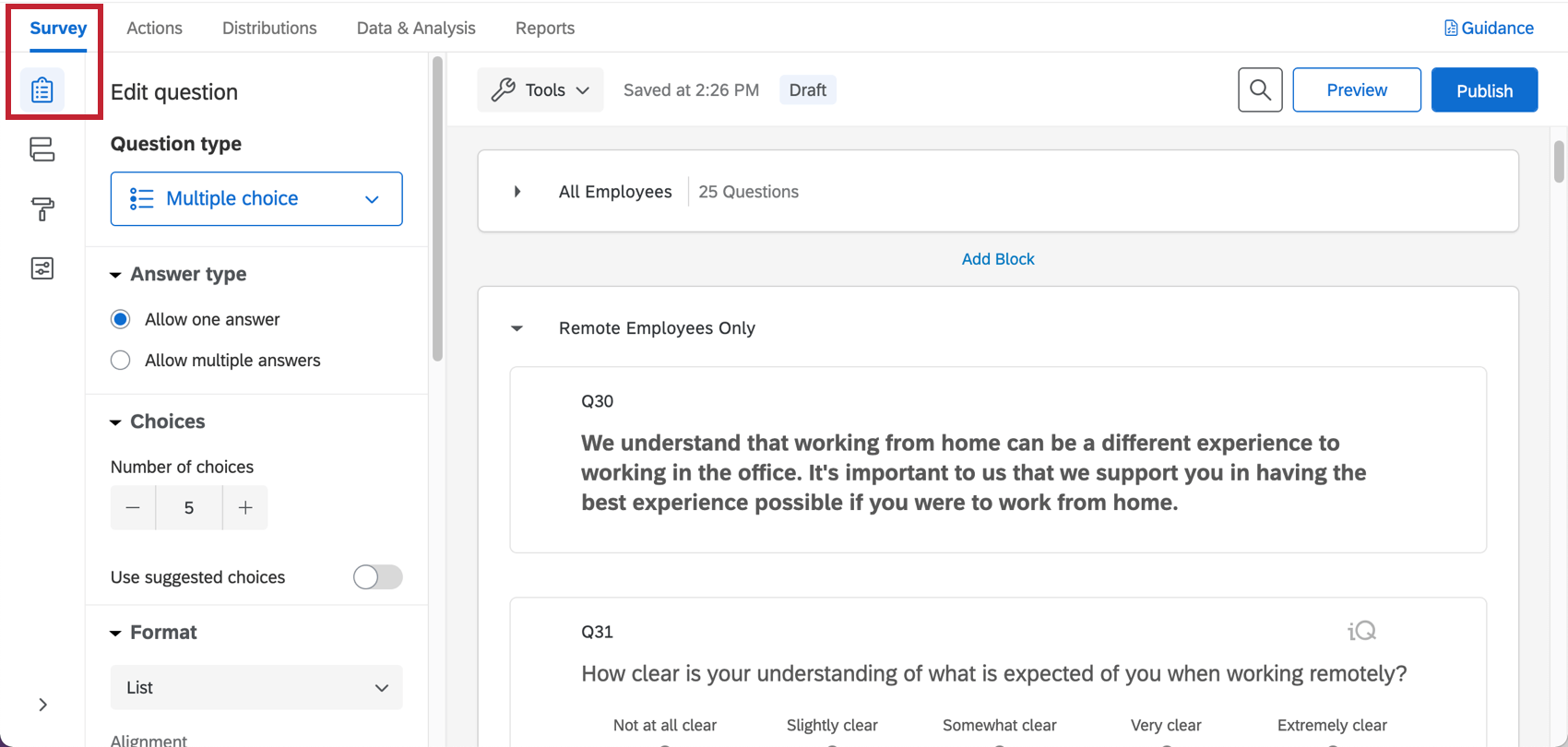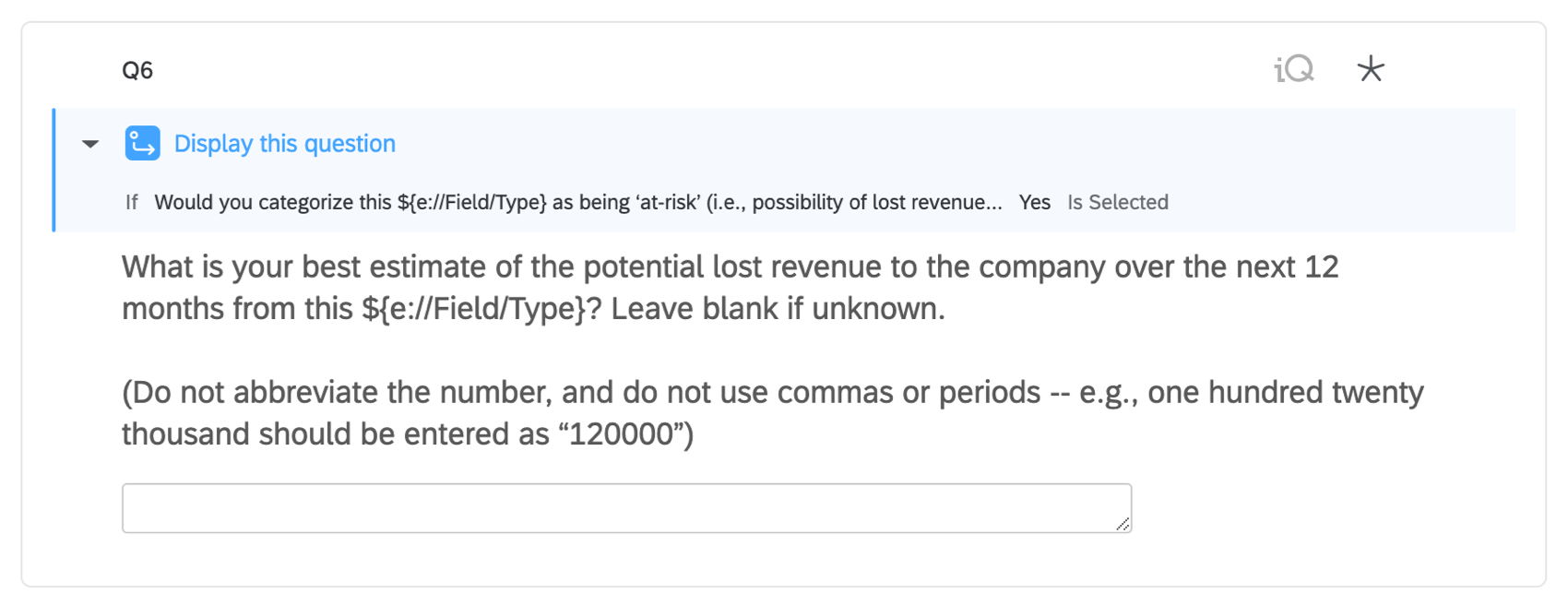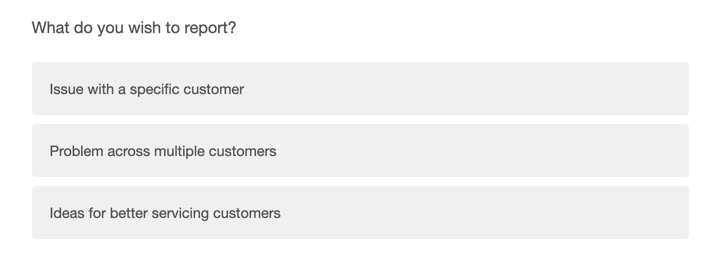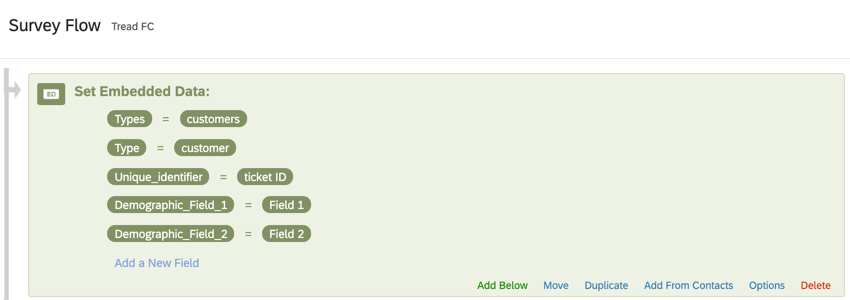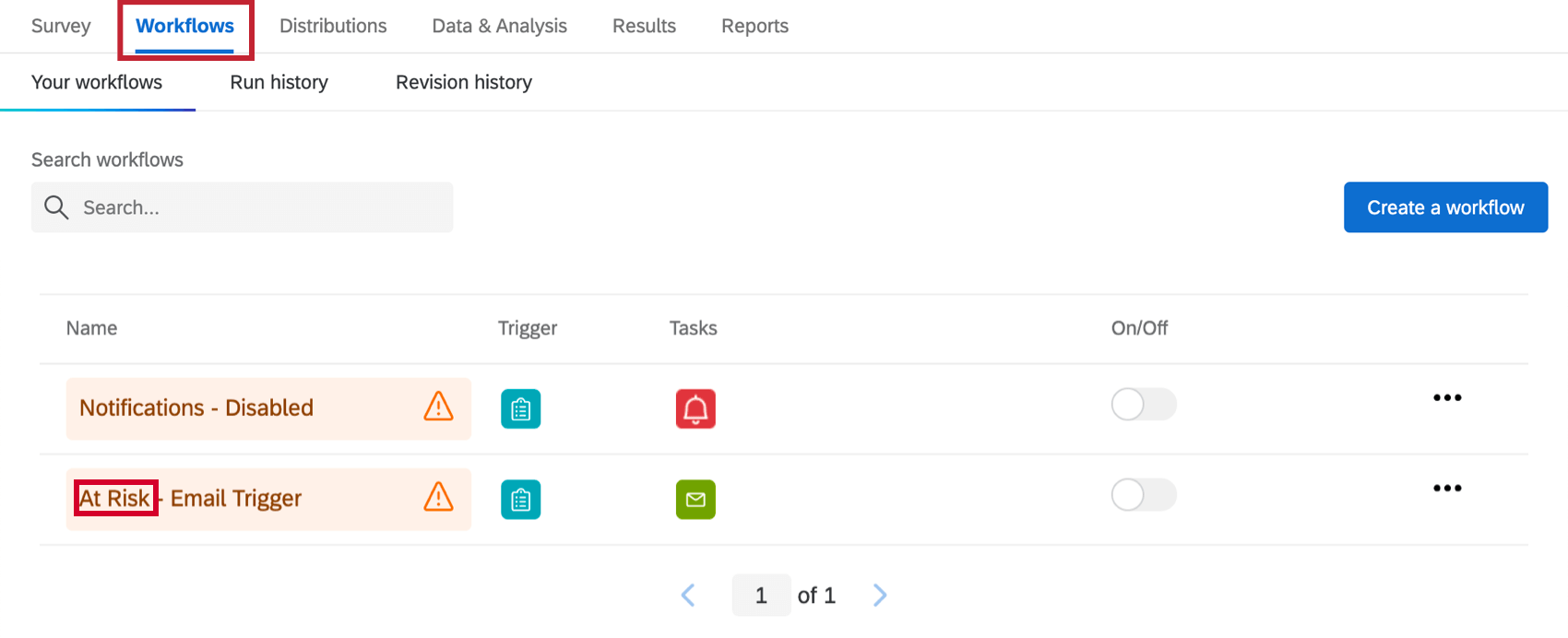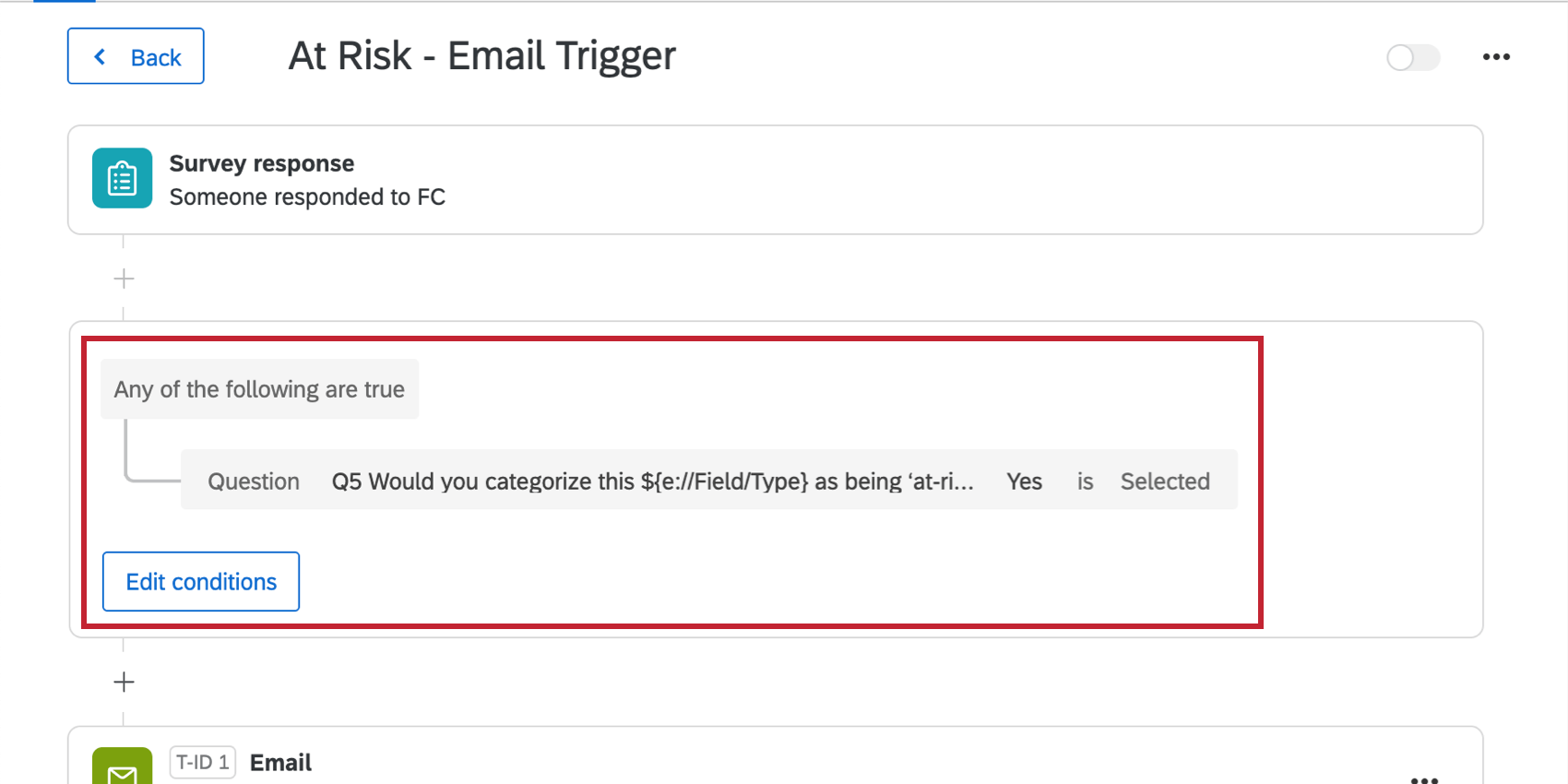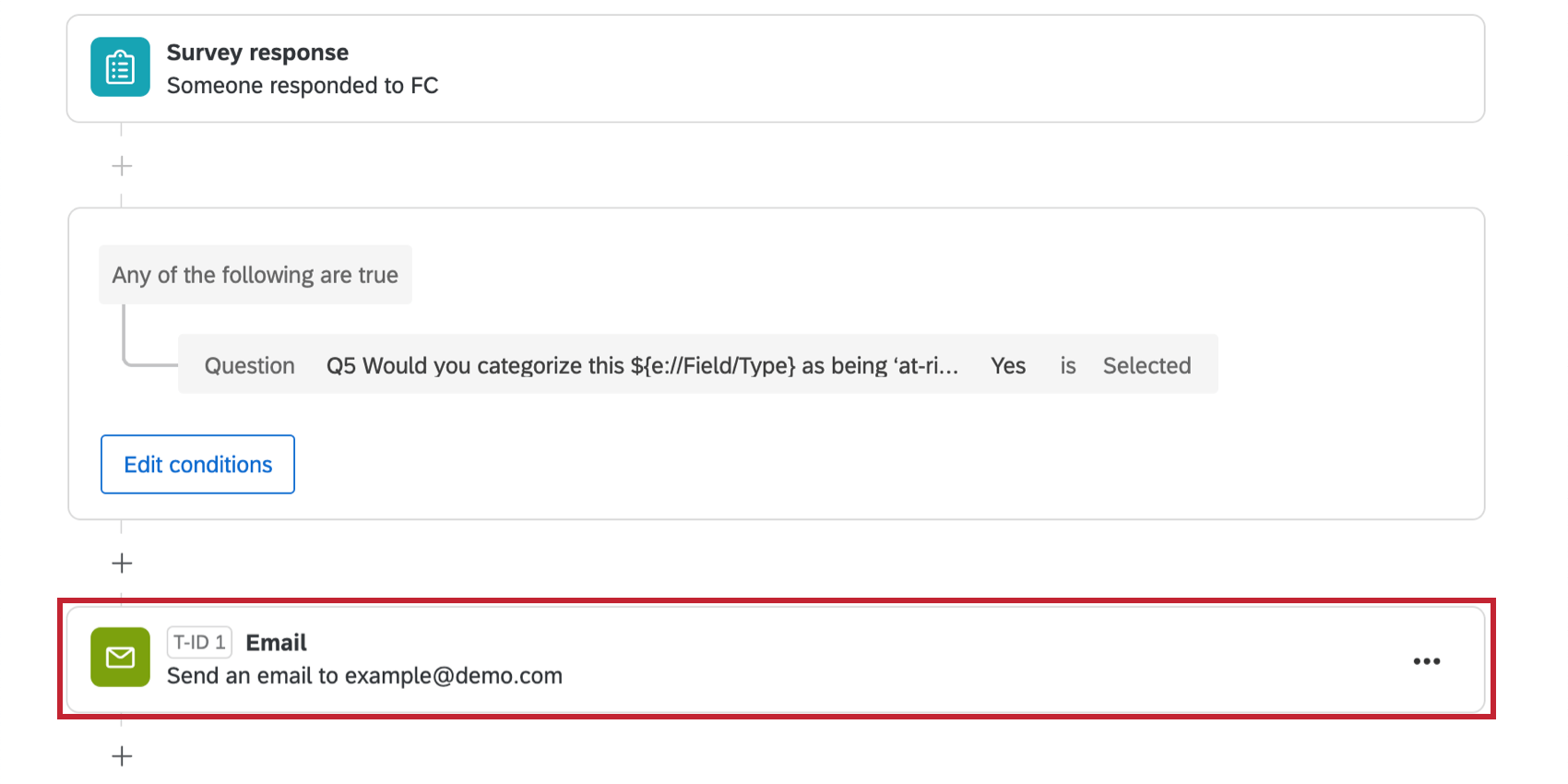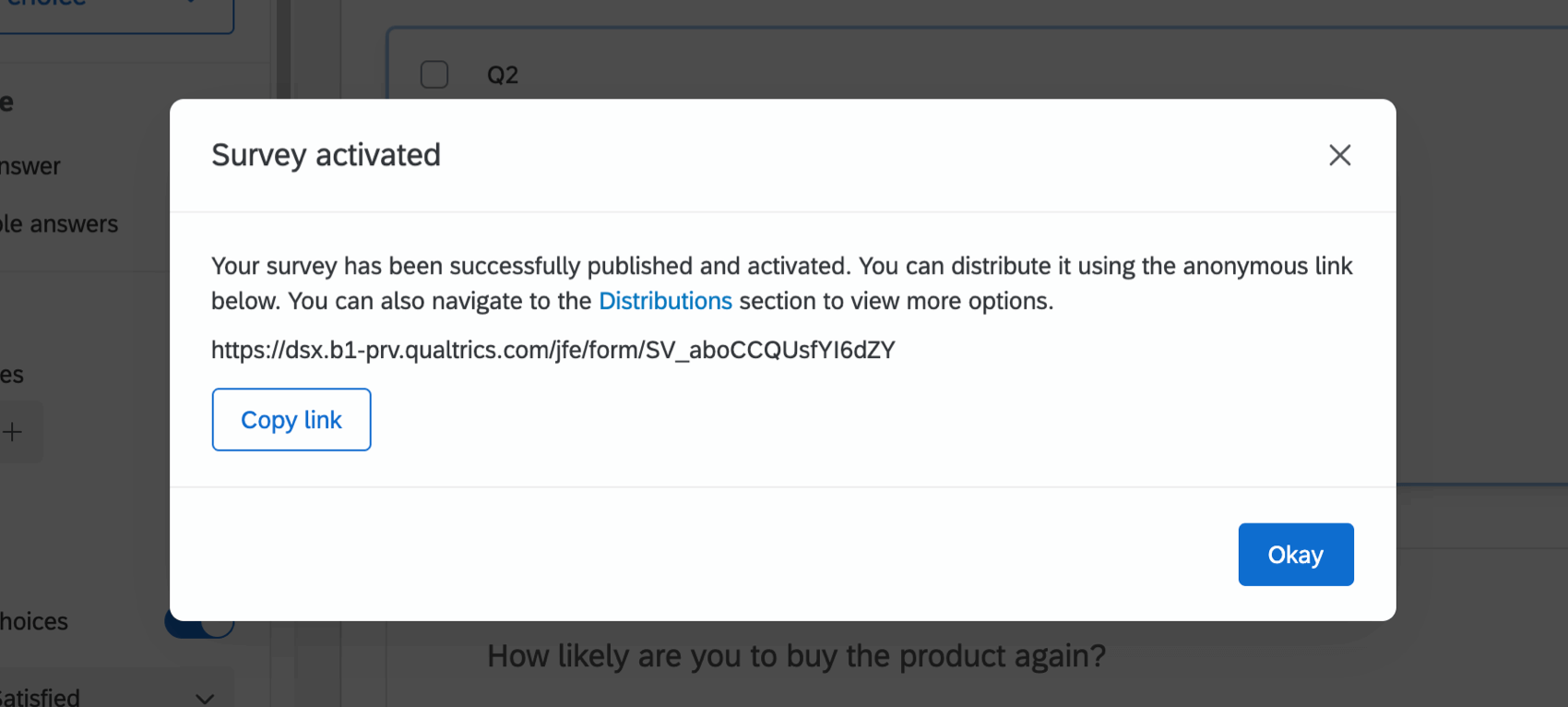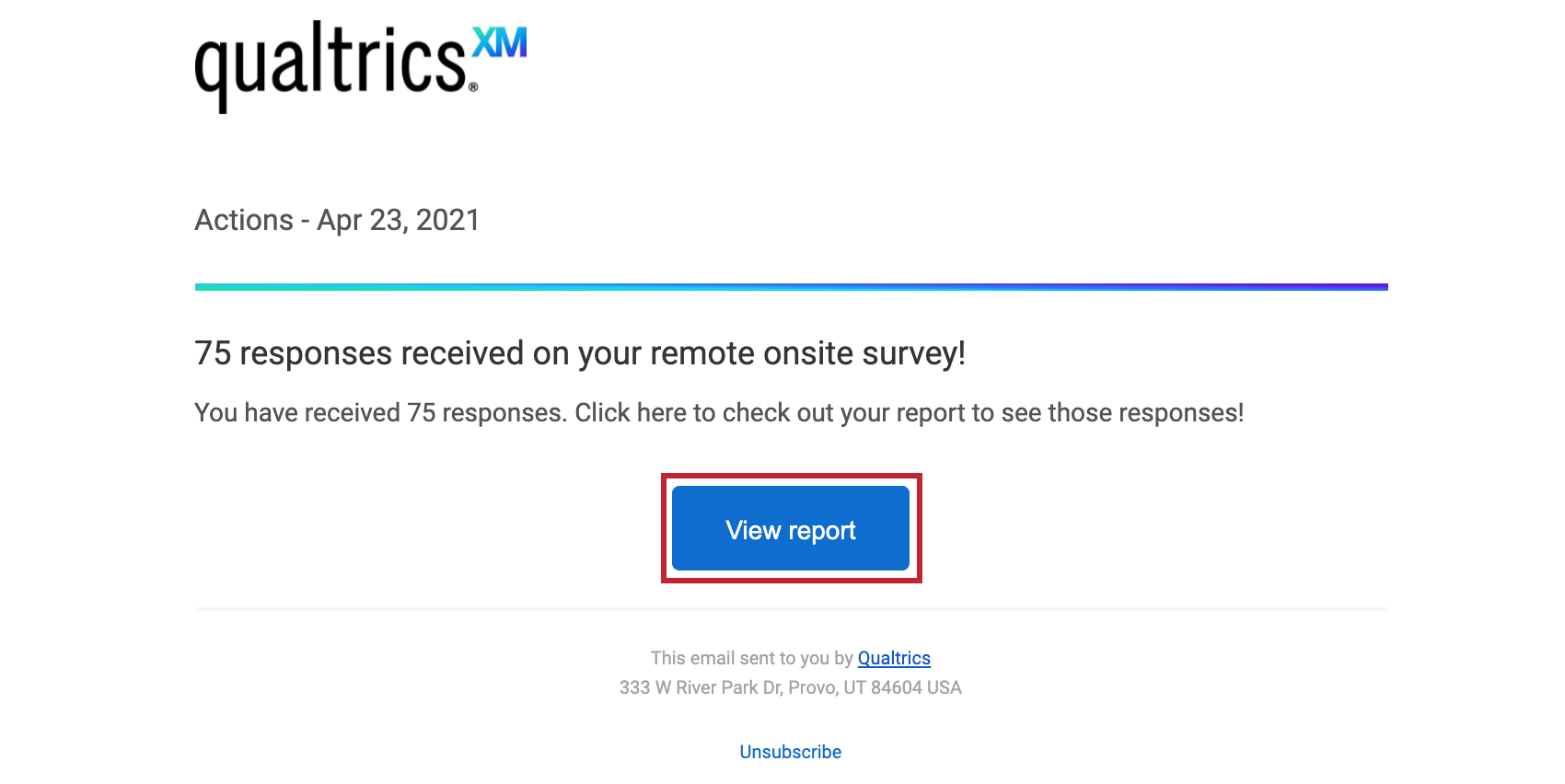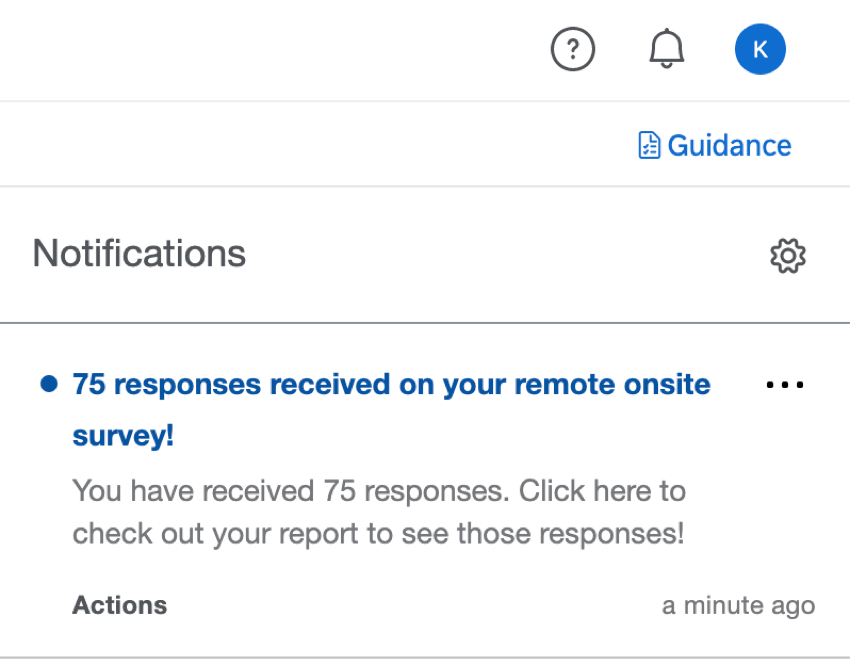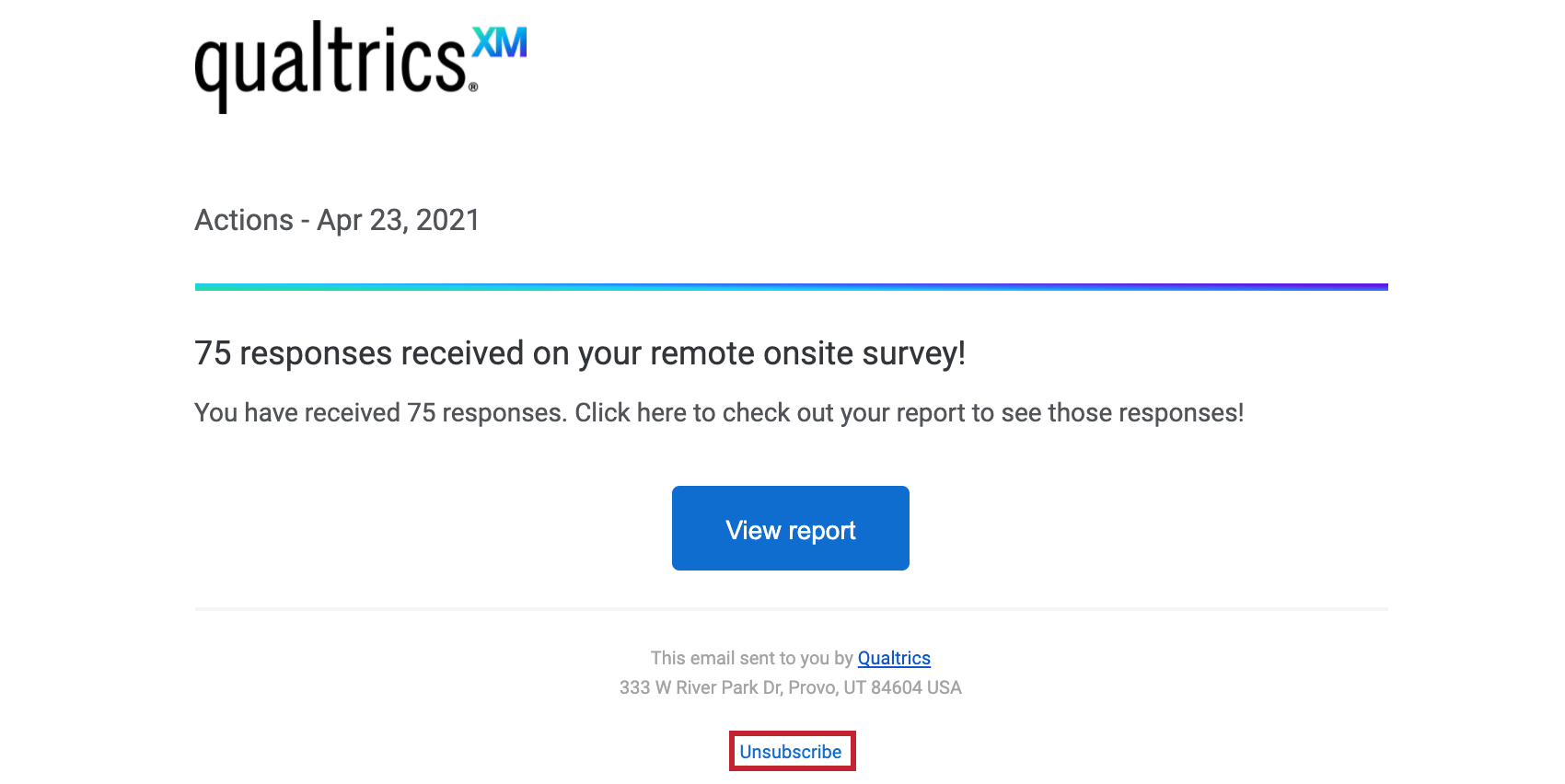Frontline Connect
About the Frontline Connect XM Solution
The Frontline Connect XM Solution provides a simple, yet robust way of gathering important feedback from frontline employees who have their pulse on the issues and challenges currently facing customers. Feedback is gathered online from frontline employees via a re-usable link that can be posted to the organizational intranet, saved to an individual employee’s workstation, or sent in emails from managers to their staff.
The Frontline Connect XM Solution contains the following:
- a pre-written survey
- a pre-made CX Dashboard
Creating the Frontline Connect
- Select Catalog from the global menu.
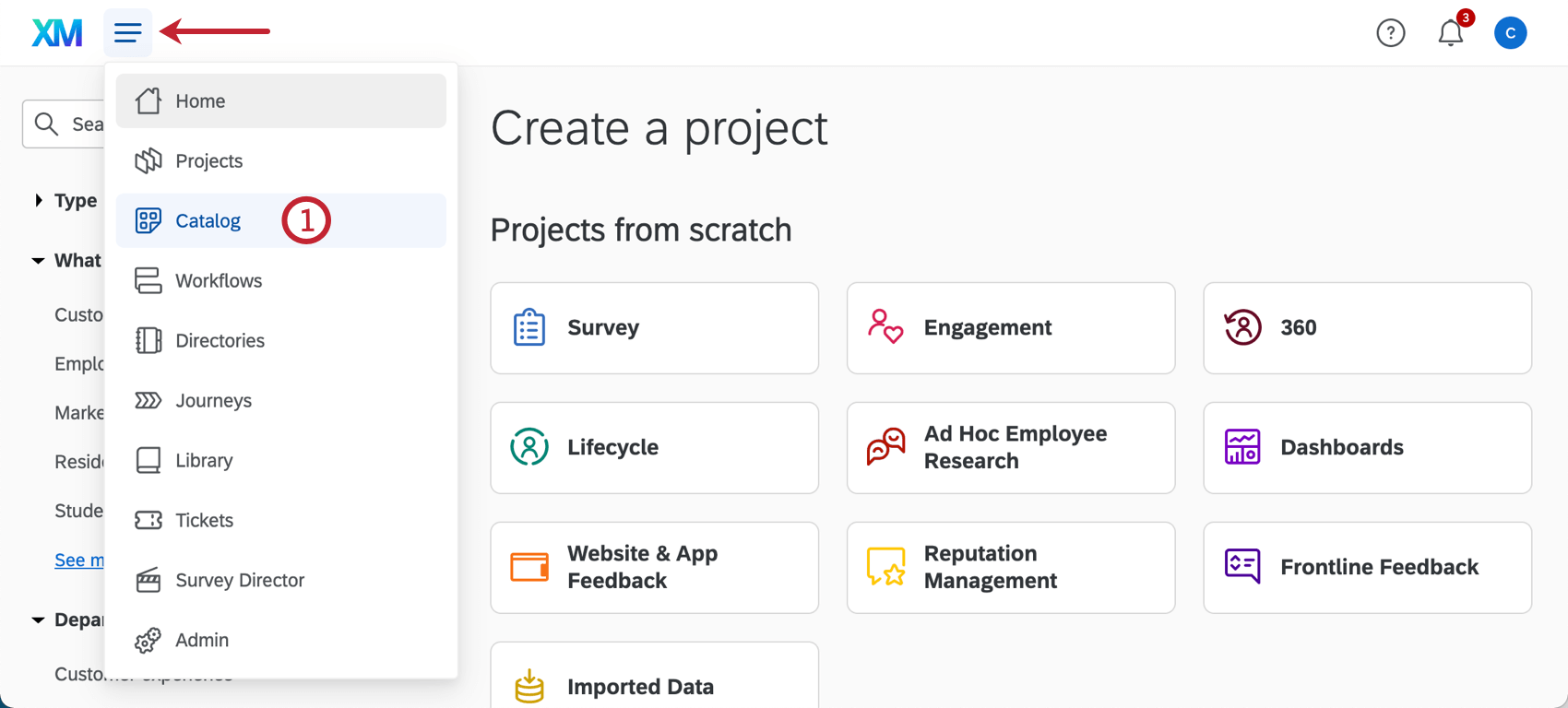 Qtip: A project can also be created from the Projects or Homepage.
Qtip: A project can also be created from the Projects or Homepage. - Under COVID-19 projects, select Frontline Connect.
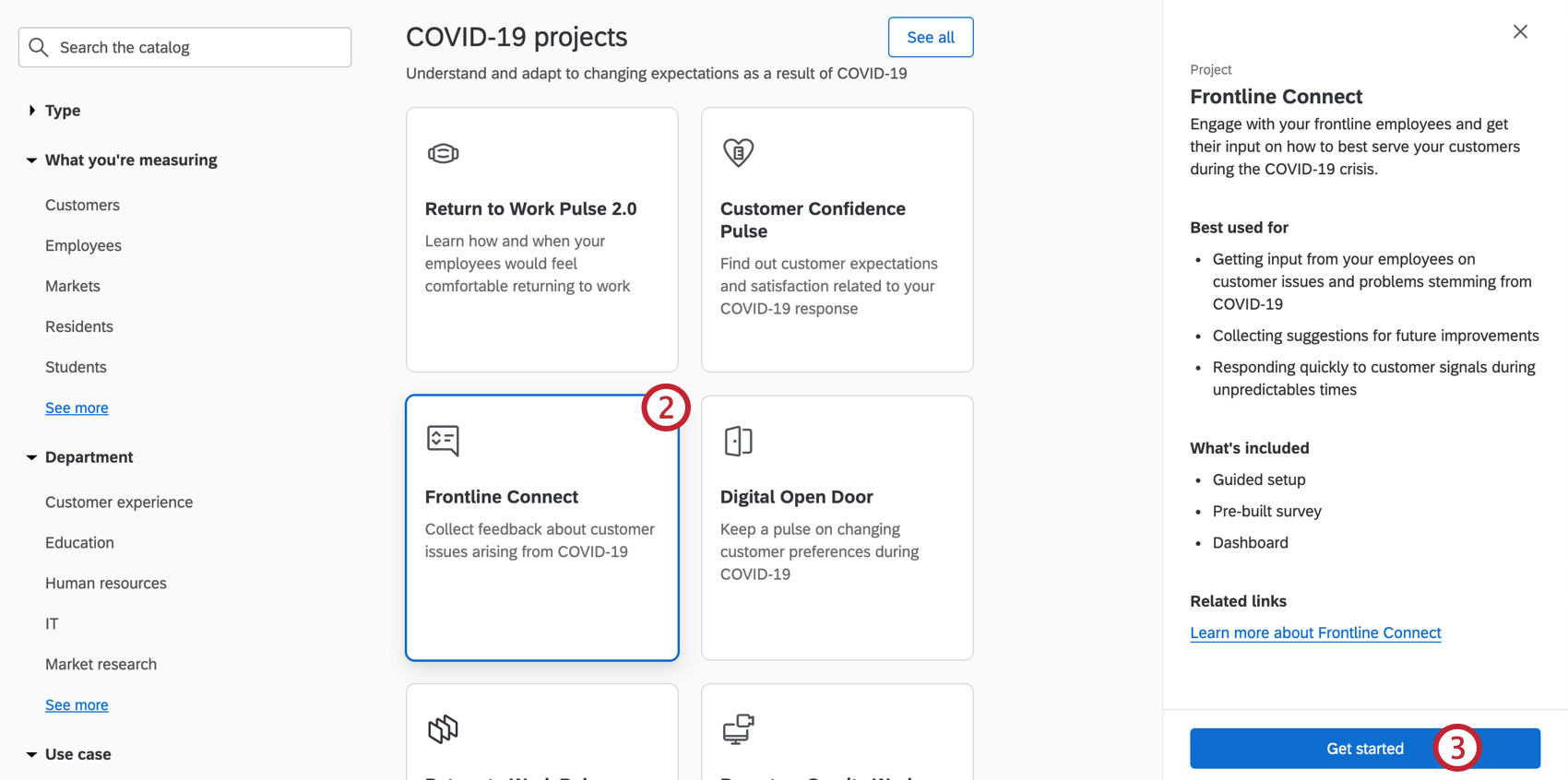 Qtip: You can also use the search in the catalog to find this project.
Qtip: You can also use the search in the catalog to find this project. - Click Get started.
- Name your project.
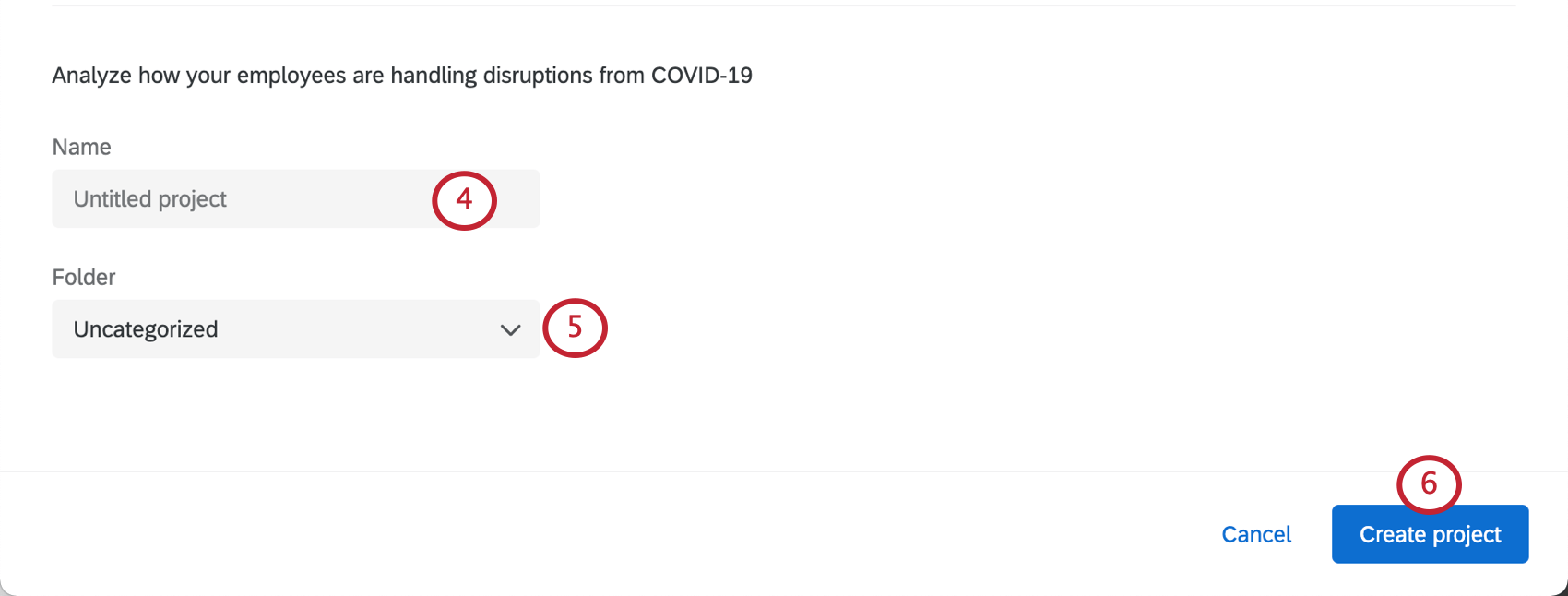
- If desired, put it in a folder.
- Click Create project.
- If desired, upload a copy of your organization’s logo. Max file size is 1MB.
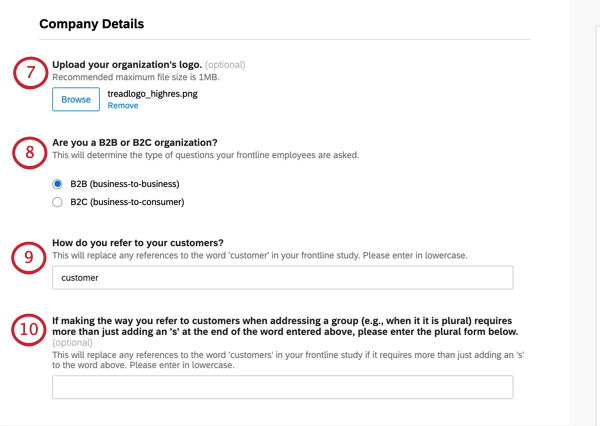
- Select your company’s type. Your answer determines the type of customer information you can configure in the next steps.
- B2B (business-to-business): Your company creates solutions, services, or products intended to help businesses run more smoothly.
- B2C (business-to-consumer): Your company creates solutions, services, or products for the everyday consumer.
Qtip: If you choose B2C, you will not see the options described in Steps 13-19.
- Specify how you refer to your customers.
- If the plural form of the word entered in the previous step isn’t just the same word with an “s” at the end, enter it here.
- If you chose B2B, determine whether you want to be alerted by email when your frontline employee indicates that a customer is “at risk.” If you answer yes to this question, provide the email address the alerts should be sent to.
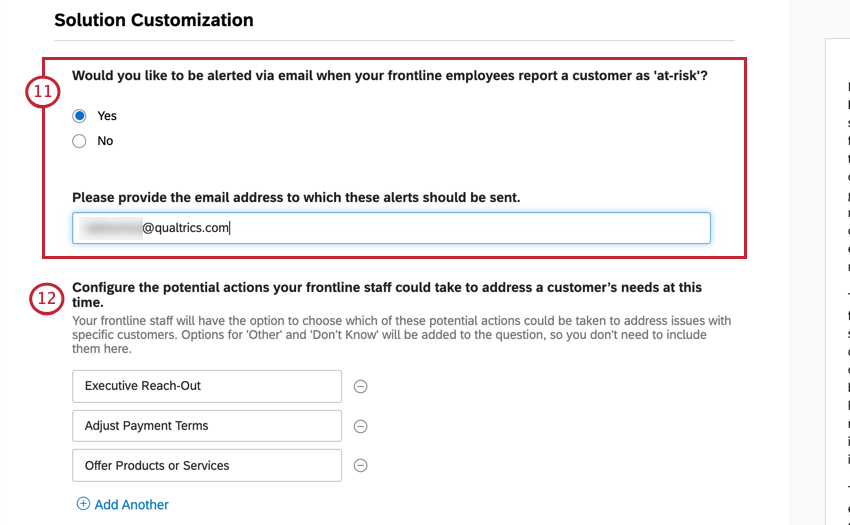
- If you chose B2B, list the potential actions your frontline employee can take to address a customer’s needs at that time. We provide a few examples.
- If you chose B2B, determine whether you want your frontline staff to provide a unique customer ID or account identifier specific to customer accounts when they report an issue. If so, specify the name of the identifier, such as “unique ID” or “account ID.”
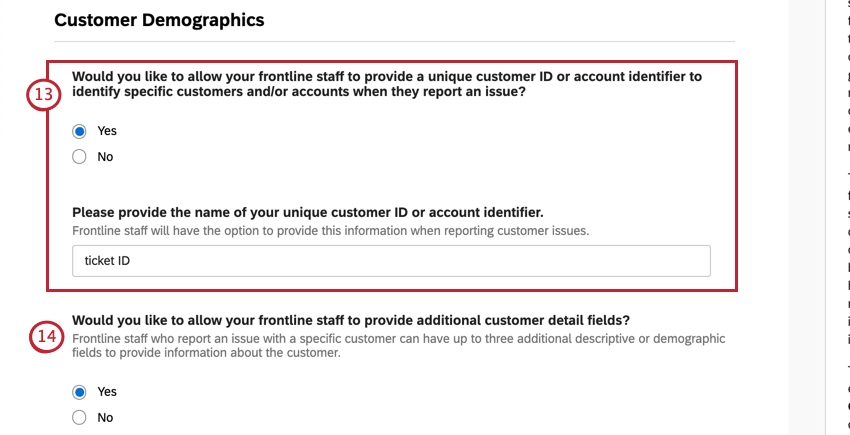 Example: If you run a software company, the unique identifier might be “username.”
Example: If you run a software company, the unique identifier might be “username.” - If you chose B2B, decide whether you want frontline staff to provide additional customer details.
Qtip: Think of the information that would be useful to the teams troubleshooting this issue.
- Add a field name. For example, “Region.”
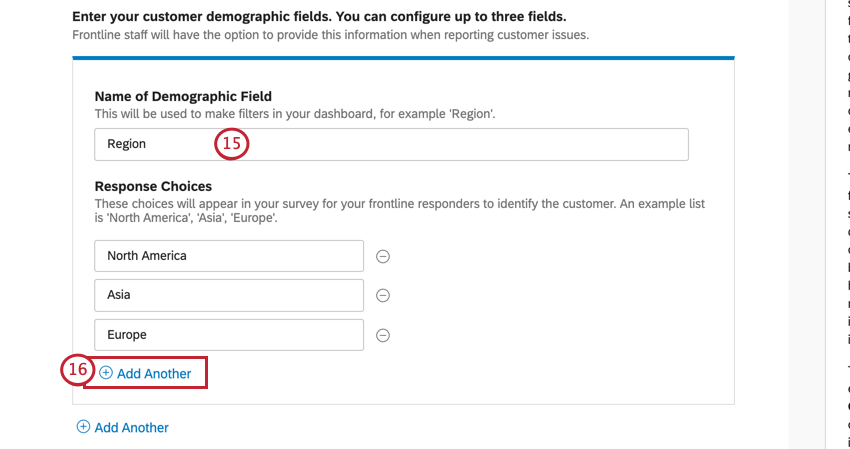
- Use Add Another inside the box to add response choices. For example, “North America,” “Asia,” and “Europe.”
- Use Add Another outside the box to add a new demographic field. For example, now we’ve added “Industry.”
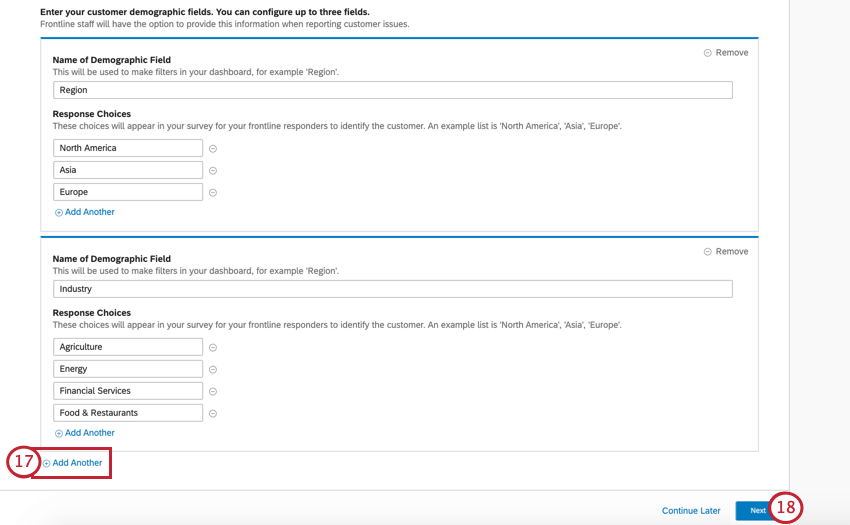
- Click Next.
- Determine when you would like response notifications sent to you through email and in-account notifications. You can choose between:
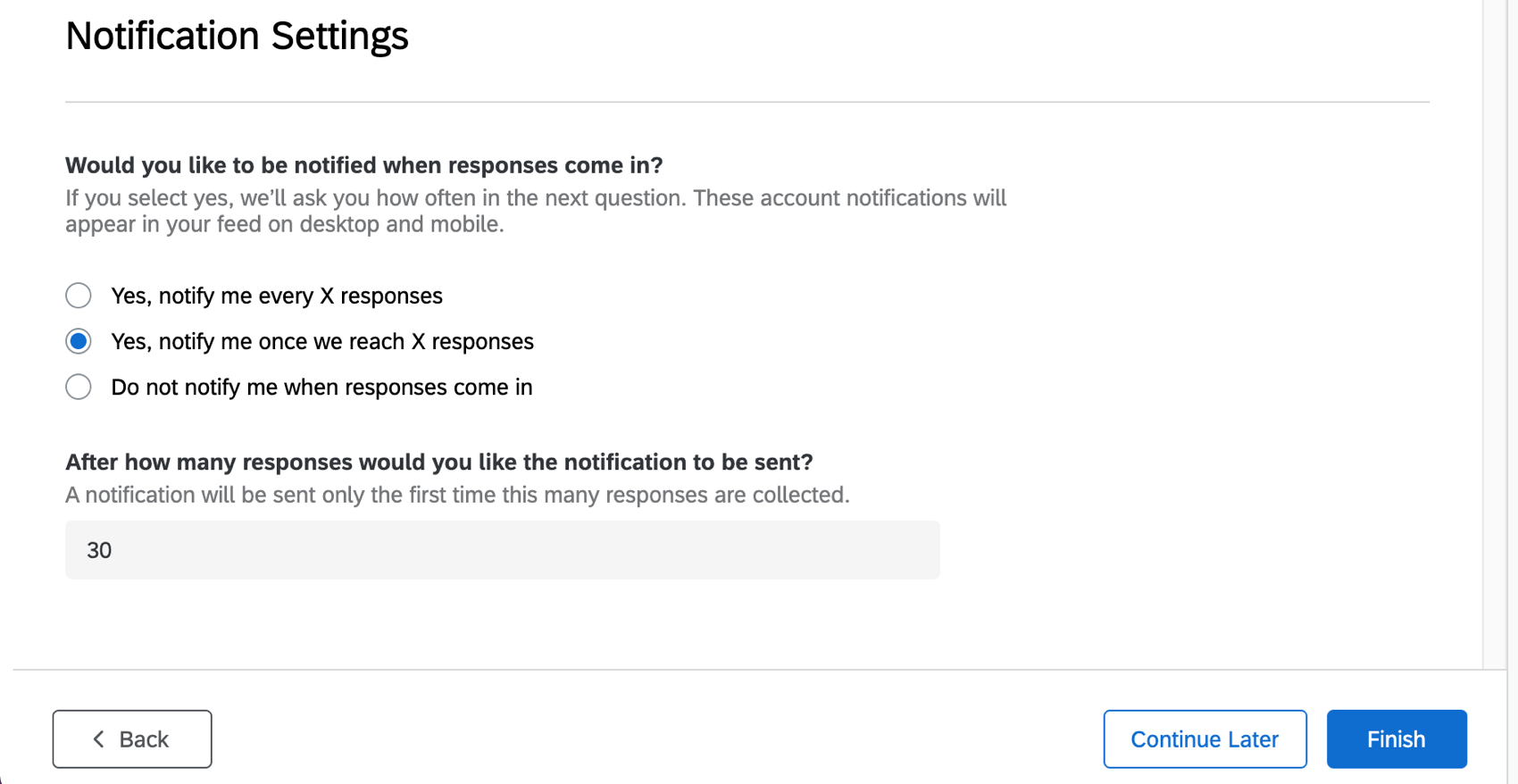
- Yes, notify me every X responses
Example: Get notified for every 50 responses you receive, so you don’t get a notification for every response.
- Yes, notify me once we reach X responses
Example: Get a notification once you reach 150 responses, total.
- Do not notify me when responses come in
- Yes, notify me every X responses
- When you’ve filled out these fields, click Finish to generate your survey.
- Click Preview Survey to test your survey.
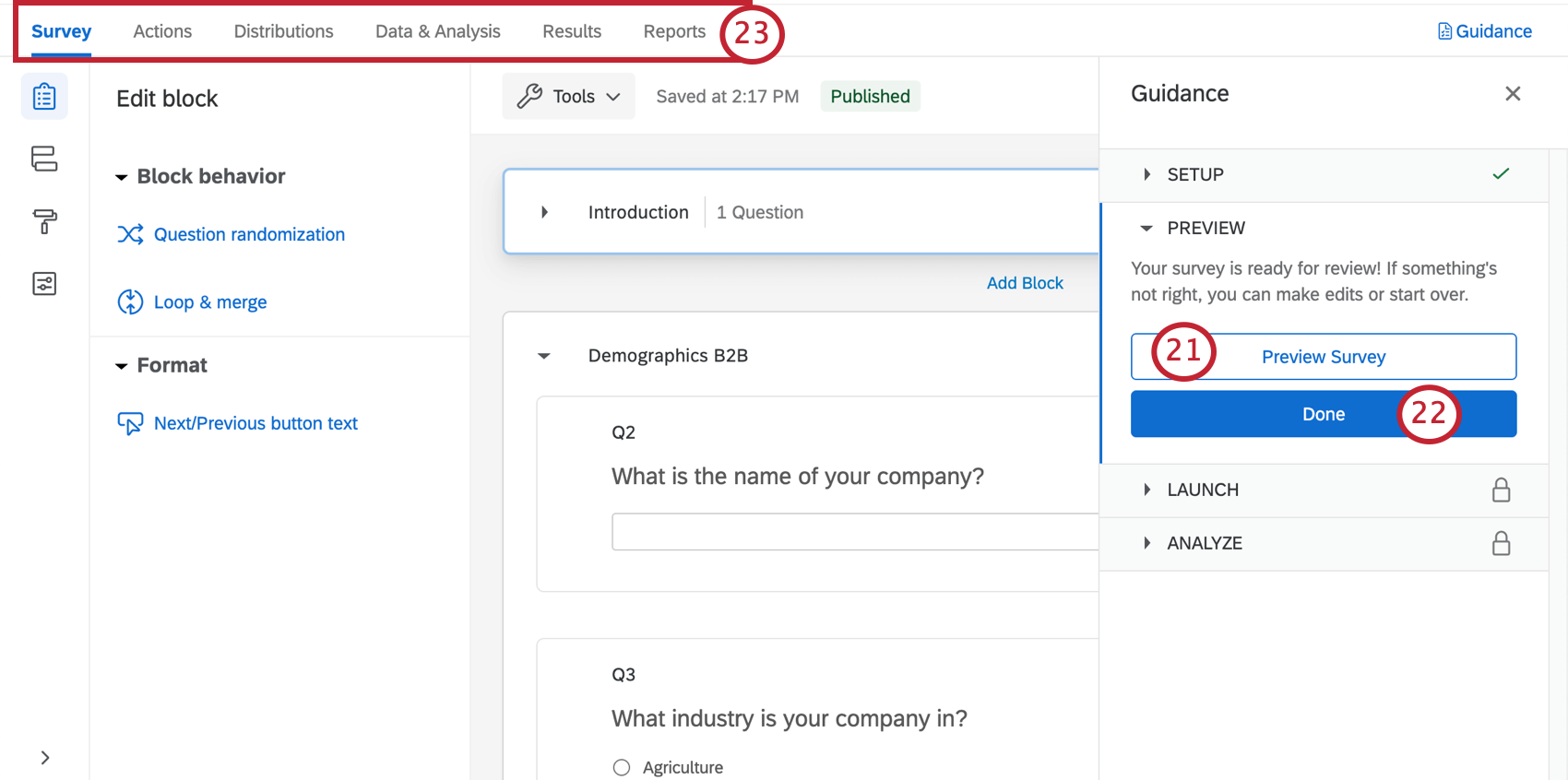 Qtip: Did your survey Preview not appear? Make sure your browser doesn’t block pop-ups on Qualtrics.
Qtip: Did your survey Preview not appear? Make sure your browser doesn’t block pop-ups on Qualtrics. - Click Done to resume the guided setup.
- Use the tabs along the top if you’d like to edit components not included in the blue button steps. For example, you can go to the Survey tab to edit the survey theme and add demographic questions, whereas you can go to the Distributions tab to download a distribution history for emails you’ve sent.
Frontline Connect Survey Customization
If you want to see the questions in your survey or edit them, click the Survey tab. Once inside the survey builder, you can add new questions, tweak the wording on existing ones, edit the survey theme, and much more.
If there’s particular functionality you’d like to add, try searching the Support Site, or use the Support Site’s menu to the left to pick a page. In this section, we’ll cover some of the fundamentals of survey editing.
Adding and Editing Questions
You can add as many additional questions as you want. However, keep in mind that the shorter the survey, the more likely customers are to fill it out.
For guides to adding and editing questions, see:
Deleting and Restoring Questions
If you have sent a question to the trash, it is possible to restore it. To roll back many changes at once, see also how to revert a survey back to a previous version.
Display Logic
This solution comes with custom display logic. Display logic affects what questions respondents see, based on previous answers they provided. For example, we can ask the employee if a customer seems to be at risk for churn or loss of revenue, and then ask additional clarification questions based on if they said yes.
Piped Text
In the survey, you’ll notice a lot of questions have bracketed text in them. This text is called piped text, and it acts as a placeholder for other values. In this case, certain specifications you made in setup – the most common being how you refer to your customers – will be placed where the brackets are.
Don’t worry – when your employees are completing the survey, they won’t see the Piped Text. Here’s how this same question looks when accessing the survey link or previewing:
Survey Flow
In the survey flow, you’ll find an embedded data element at the top. This element helps organize your data for reporting.
You may also see branch logic in your survey flow. This feature allows you to hide or show entire groups of questions based on answers respondents gave earlier in the survey. (Kind of like display logic, but on a larger scale.) Please do not remove or edit this element without paying close attention to the question the logic is based off of and the block of questions the branch logic is controlling.
Example: The employee specifies what kind of issue they want to report. Based on this, they are sent to a specific block of questions based on that particular kind of issue. If they want to report a specific customer issue, they will go to the “Specific Customer Issue” block.
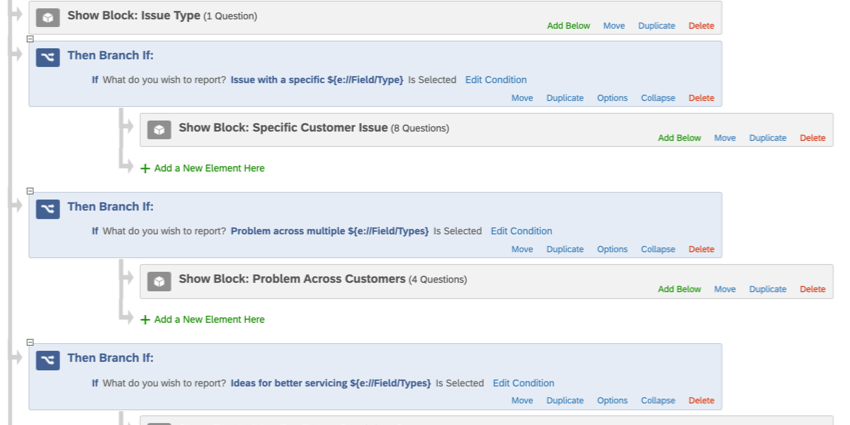
Saving and Publishing
All edits you make are saved automatically; however, they won’t necessarily be pushed to the live version of the survey. When you are finished with all of your edits and are ready to generate a link and share the survey with your customers, remember to click Publish in the upper-right.
For more on how this works, see Survey Publishing & Versions.
Pre-Configured Workflows
The Frontline Connect comes with items already set up in the Workflows tab. This means that during the project’s setup, you did one of the following:
- You said you’d like to be notified if a frontline employee indicates a customer is “at risk.” As a result, we created an email task that will go out to your specified teams / colleagues letting them know that a customer is at risk.
- You said you’d like to be notified when you receive a certain number of responses. As a result, we set up an notifications feed task so you will be alerted appropriately.
As needed, you can either review or edit:
- Who receives the notification
- The conditions under which the condition are sent
- The message included in the notification
About the At-Risk Notification
The email will only be sent if the employee filling out the survey indicated that they would categorize the customer as “at-risk.”
Qtip: For more on building conditions, see:
Click Email to view details such as who’s the recipient of the email notification, the message, and other settings.
By default, the message contains:
- The date the customer completed the survey
- Their first and last name
- Their preferred email address or phone number
- The email saved for them in the contact list
- A recommendation to reach out to the customer within 48 hours
For additional details and editing options, see the Email Task support page.
About the Response Notifications
Depending on the frequency you chose, these conditions are set up with one of the following:
- Embedded data set in the survey flow.
- Quotas.
Do not edit the conditions on these workflows, the corresponding embedded data in the survey flow, or the quotas involved.
If you don’t want to receive this notification after all, you may delete the workflow. Please note that once you delete a workflow, it cannot be retrieved.
Sharing the Frontline Connect with Employees
Once you are completely finished with survey edits and your contact list is ready, it’s time to distribute your survey.
- Make sure you have published any survey edits.
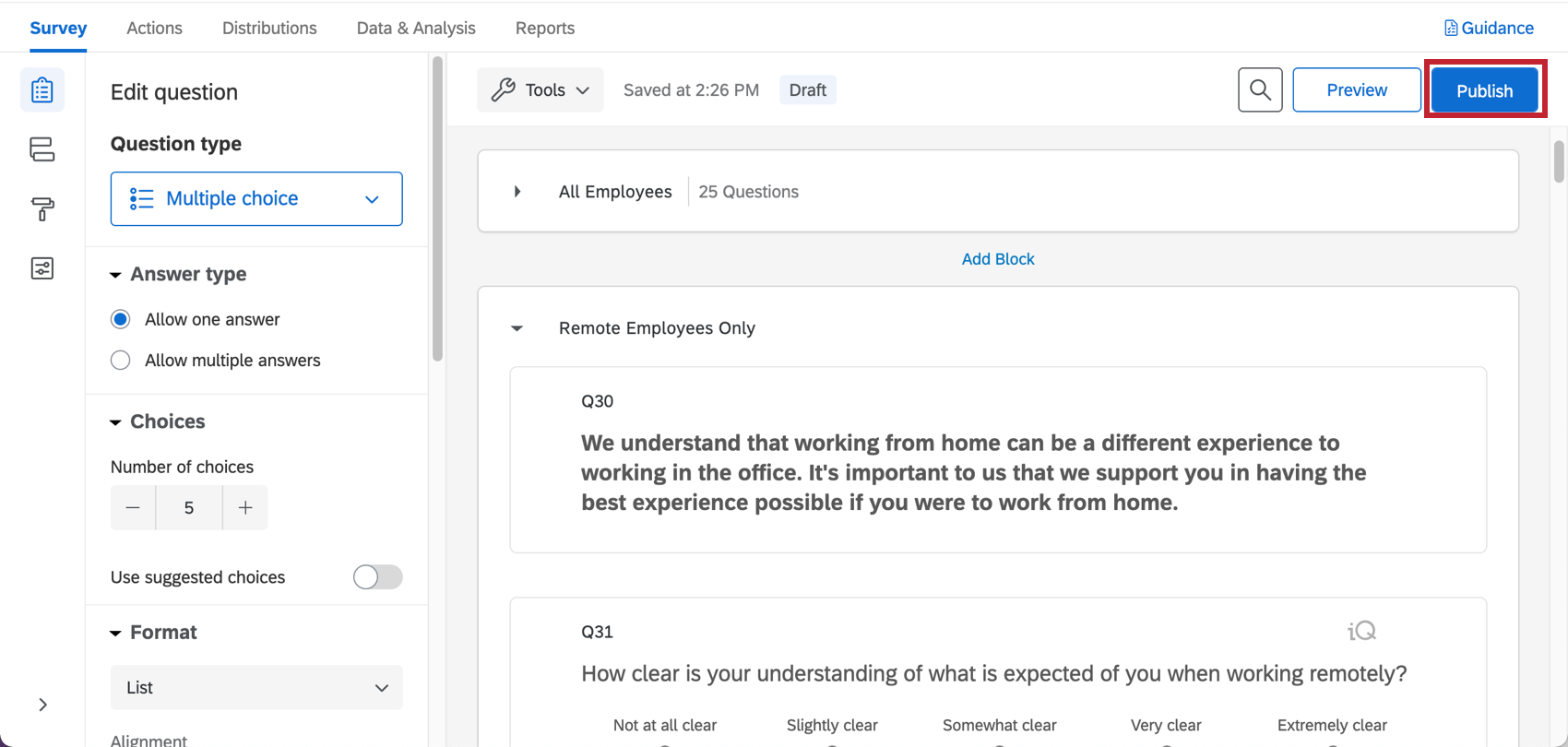
- Open the Guidance panel.
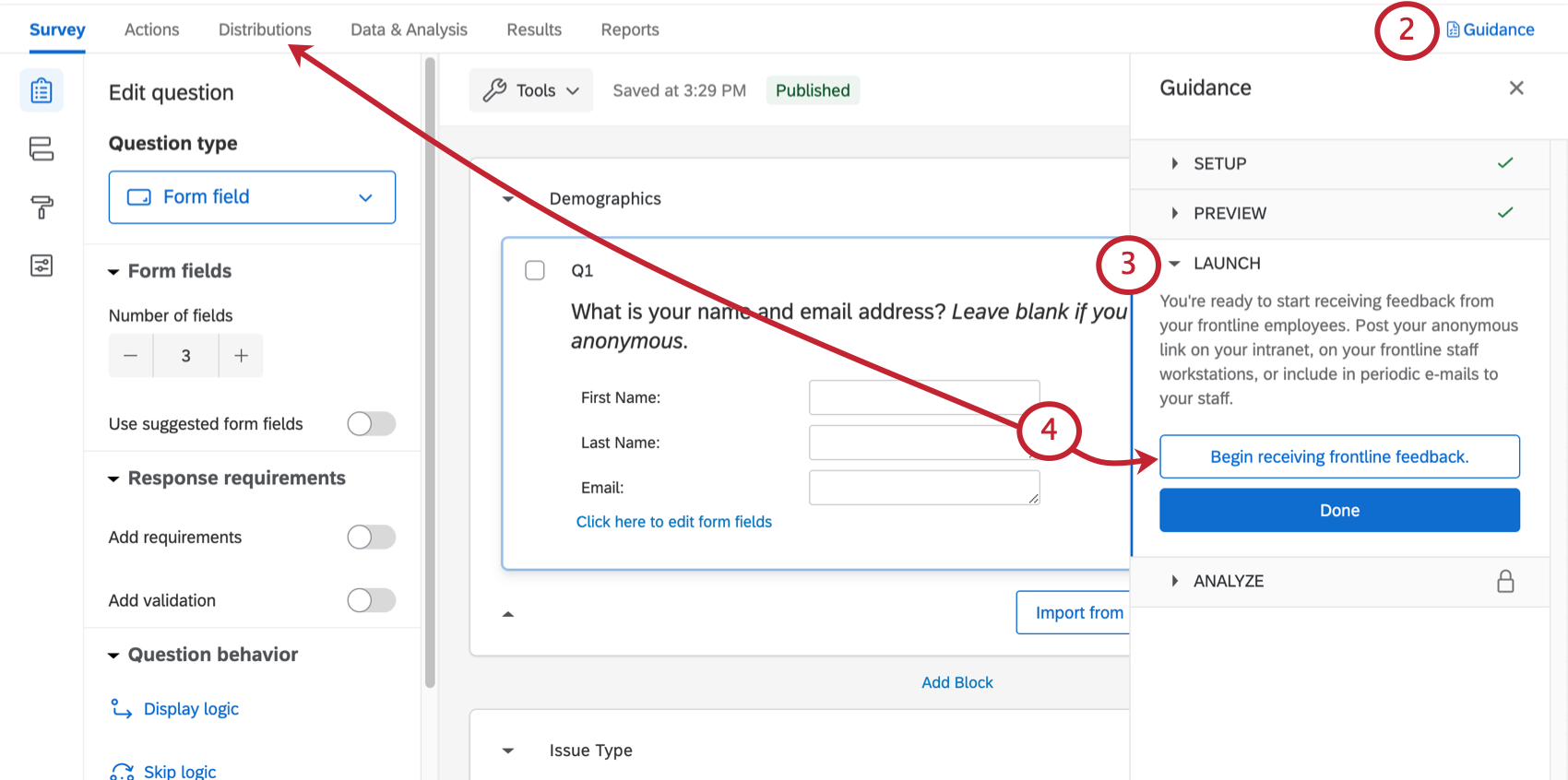
- Navigate to the Launch section.
- Select either Distributions or Begin receiving frontline feedback.
- Click Anonymous Link to the left.
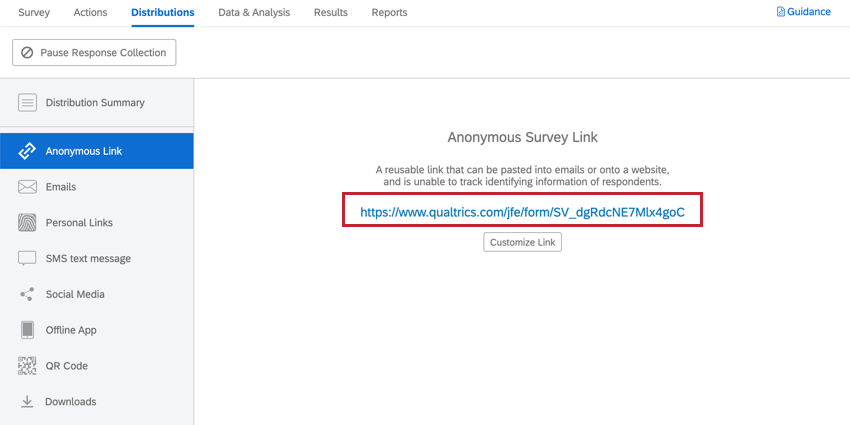
- Copy the link and share it as desired – for example, post it to your internal employee intranet site, save it to an individual employee’s workstation, or have managers email it to their staff.
Other Distribution Options
If you are interested in other methods of distribution, such as SMS or emailing a contact list, see the Distributions Basic Overview for a list of options. Please note that depending on your license, not all options may be available, and some may be restricted.
Dashboards
Premade Dashboards
Our XM Scientists have developed a special dashboard for this XM Solution. This dashboard gives an overview of the results, and is ready to share as soon as you have collected data. The pages of the dashboard and the data included will depend on the type of assessment you chose and whether you have decided to give respondents an option for follow-up.
- Open the Guidance panel.
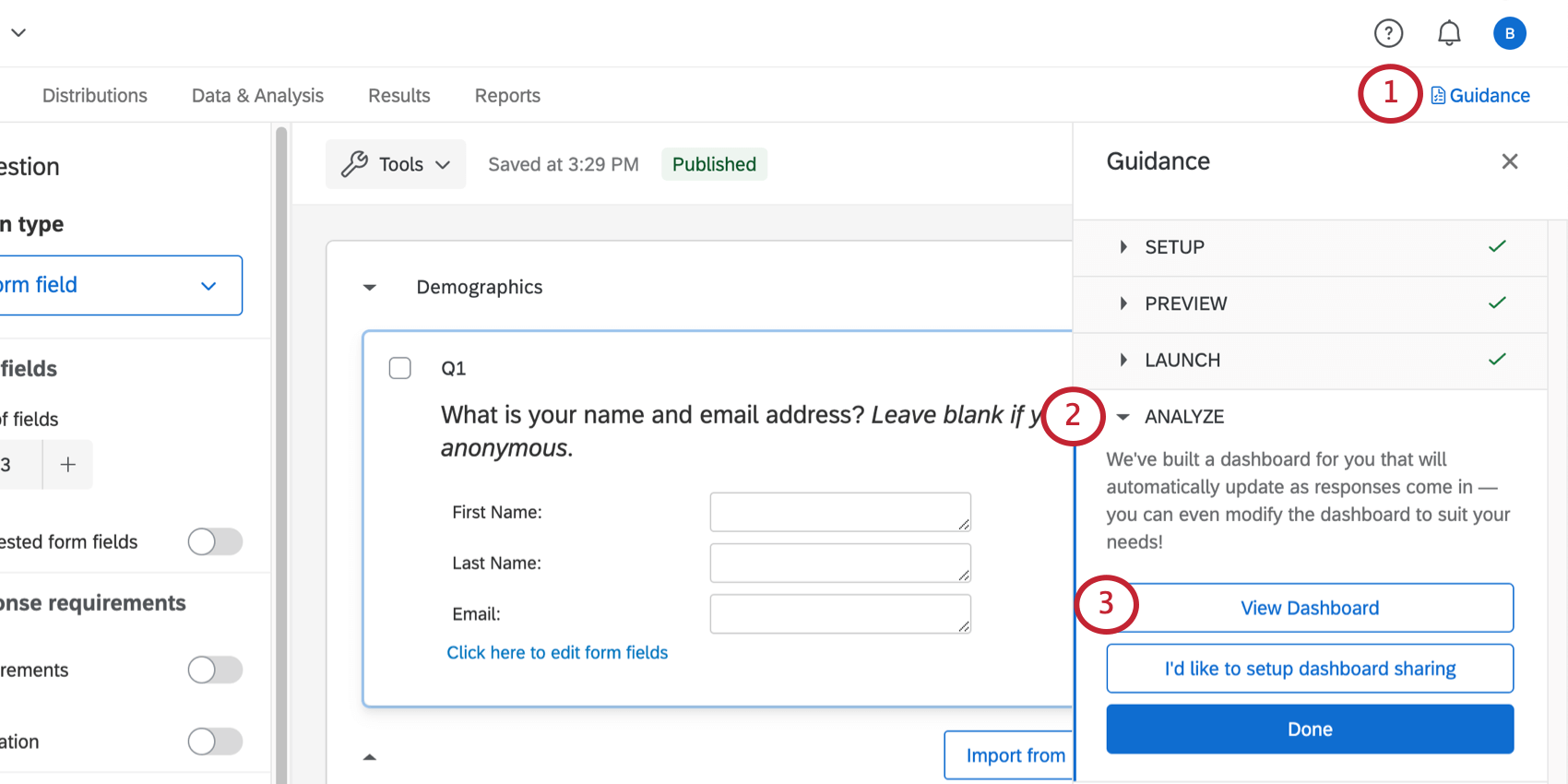
- Navigate to the Analyze section.
- Click View Dashboard to enter the dashboard.
- Scroll through the widgets and select pages to the left to see your data.
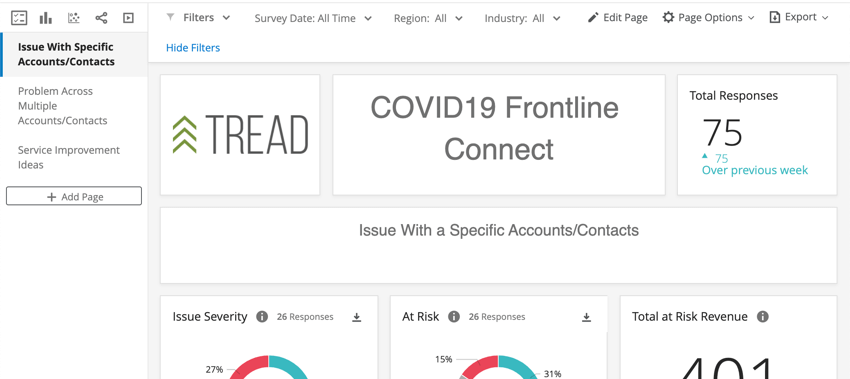
If you instead selected Set up dashboard sharing, you’ll be redirected to the User Admin tab. See Sharing & Administering Users for guidance on what changes you can make here, and what kind of Qualtrics users can access this tab.
Dashboard Editing
Check out these introductory pages to get started.
- Getting Started with CX Dashboards
- Step 1: Creating Your Project & Adding a Dashboard
- Step 2: Mapping a Dashboard Data Source
- Step 3: Planning Your Dashboard Design
- Step 4: Building Your Dashboard
- Step 5: Additional Dashboard Customization
- Step 6: Sharing & Administering Users
Other Ways to Access the Dashboard
Anytime you enter your project’s Overview tab, you’ll be able to select View Dashboard to enter the pre-made dashboard.
You can also access this dashboard from your Projects page. It will have the same name as your Frontline Connect project, with “- Dashboard” added to the end.
Example: Below, you can see our Frontline Connect and the corresponding Dashboard.
Once you click inside, you’ll see the pre-made dashboard. Click this to view the data.
Other Ways to View Data
The Data & Analysis tab of your project allows you to edit data, export a spreadsheet of all responses, filter your responses, and much more.
The Reports tab comes with two additional report-building features. These do not come with the dynamic, shareable filters and roles CX Dashboards have but are more basic in structure and can still be filtered and shared out to stakeholders as needed. Note that these reports will have to be built from scratch. See Results vs. Reports for a detailed breakdown of these reporting options.
Weekly Response Notifications
Built in are weekly reports of how many responses your survey has received in the past week, and how many responses that makes for the survey in total. These notifications come every Monday morning.
Reports are sent as emails and as notifications in your account.
Viewing Reports
View report: Clicking View report in the email or clicking the in-product notification will take you to the Reports section of the Reports tab of your project, where you should see the pre-built report.
Unsubscribing from Notifications
If you no longer wish to receive notifications, you can click unsubscribe at the bottom of the email.
Subscribing to Updates
Most users will be subscribed to these automatically. However, if you unsubscribed and find you want to start receiving them again, you can do the following:
- Go to your Qualtrics account.
- In the upper-right corner, click the notifications icon.
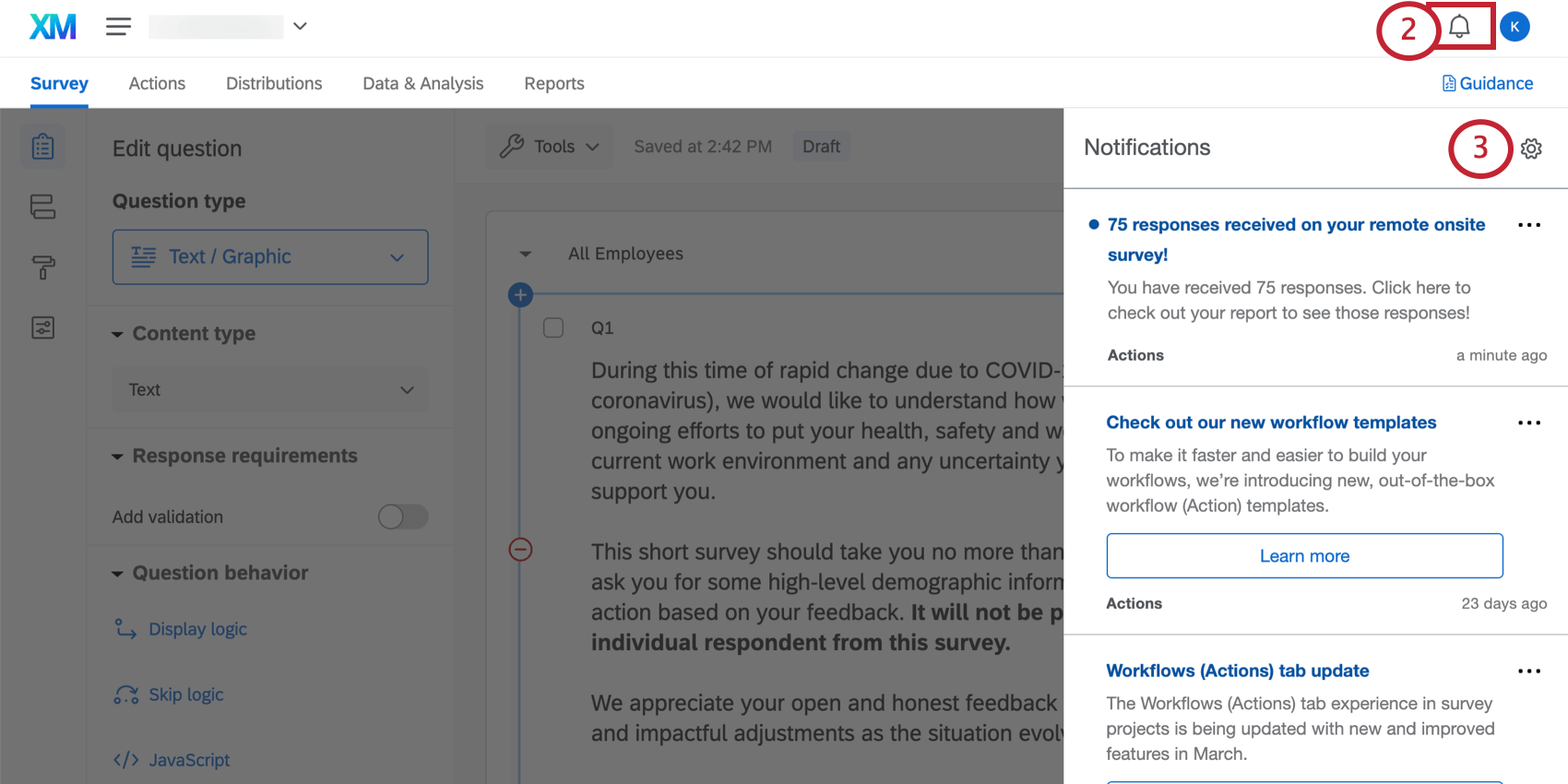
- Click the settings gear.
- Select Workflows to subscribe to notifications set up using the Workflows tab.
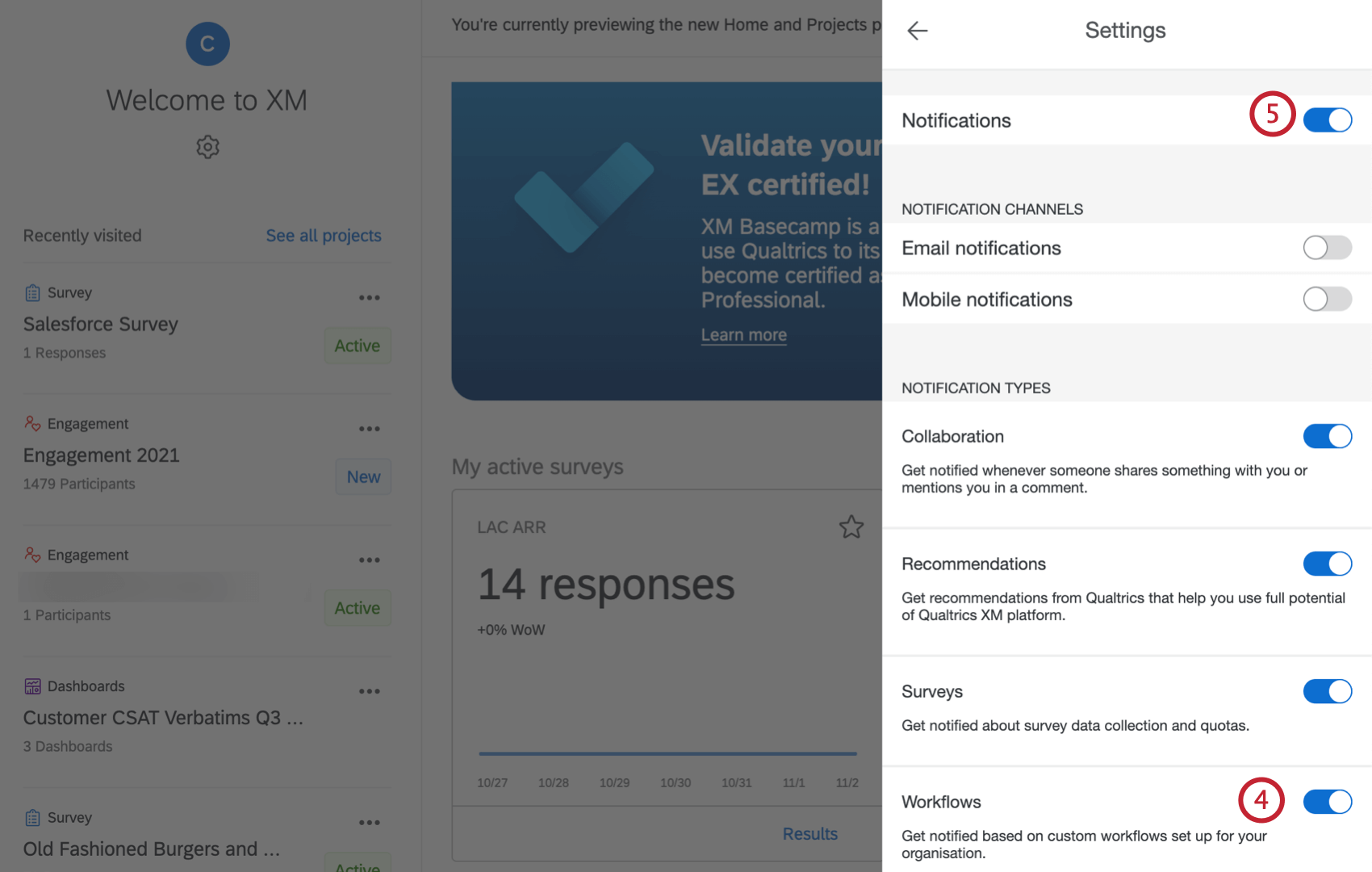
- You may need to select Notifications first if you at some time or another unsubscribed from all account notifications.
Terms of Use: CX COVID-19 Solutions
Free Accounts
For customers who sign up from the “Here to Help” or “Return to Work” landing pages or via Qualtrics Surveys, the following applies:
- Customer Confidence Pulse, Digital Open Door, & Frontline Connect: The ability to launch new projects expires 90 days after the first of these projects has been launched AND has received a response or if the customer has hit their limit of 20k total free responses received (combined across the three solutions), whichever comes first.
- Digital Open Door: Unlimited page views.
Post expiration, customers will need to export their data within 6 months or upgrade to a paid CX product.
Existing Customers
For existing customers who have a CX5 license or a CX / RC license with rights to required features (e.g. CX 1/3 with a Digital add-on), the following applies:
- There currently is no time restriction around how many Customer Confidence Pulse, Digital Open Door, or Frontline Connect projects can be created.
- Upon reaching the limit of 20k total free responses received (combined across the three solutions), additional responses will be billed to the license.
